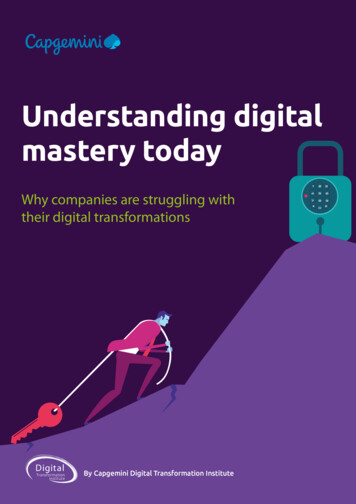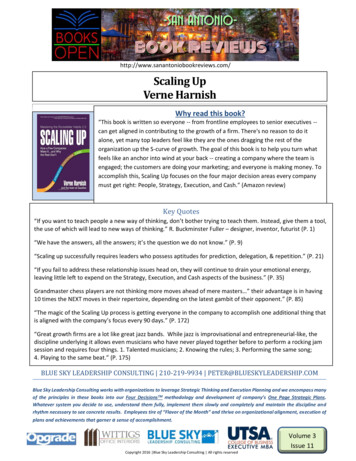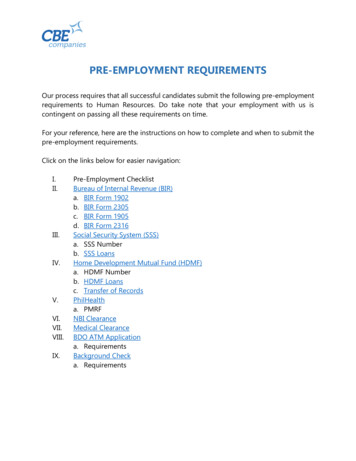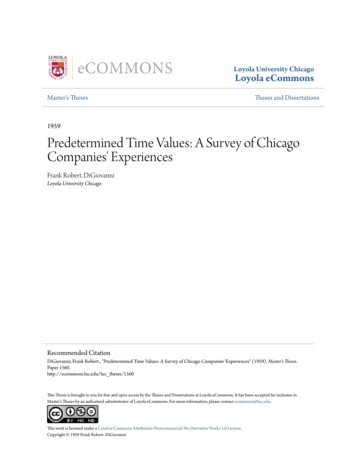
Transcription
Understanding digitalmastery todayWhy companies are struggling withtheir digital transformationsDigitalTransformationInstituteBy Capgemini Digital Transformation Institute
IntroductionThere is no doubt that organizations understand theimportance of digital transformation. Worldwide spendingon digital transformation technologies – hardware,software, and services – is expected to cross the 2 trillionmark by 2021.1 The investment commitment to putting theinfrastructure in place is not in question.But, are organizations turning these investments intosuccessful transformation journeys? In our 2012 researchwith the MIT Center for Digital Business, we establishedthat a high-performing cohort of organizations – digitalmasters – outperformed their peers in every industry.2 Sixyears on we undertook new research to gauge whether largeorganizations have mastered the art and the science of digitaltransformation.We surveyed more than 1,300 executives in over 750 globalorganizations and interviewed senior executives responsiblefor their organizations’ digital transformation programs.Six years after our original research, organizations have hadtime to build capability and experience in driving digitaltransformation and one would expect the level of digitalmastery to have progressed from 2012. However, ourresearch does not find a clear advancement. Organizationsare still struggling to turn their investments into businesssuccesses. This might reflect the difficulty for organizationsto adapt to the dizzying pace of change in technologyinnovation (e.g., artificial intelligence, internet of things,automation). Moreover, business model disruptions in manyindustries are challenging traditional value-chains. But, itcould also be that organizations were overly optimistic in2012 and have now realized the magnitude of the challenge,coupled with rising expectations of markets, employees,and customers.In this report, we focus on three key areas: An assessment of how organizations have progressed withtheir digital transformations in the last six years The major challenges that organizations face as theyimplement their digital transformations Key recommendations for how organizations can sustaintheir digital transformation journeys based on what digitalmasters do differently 00001101101Understanding digital mastery today 0 0 0 0 0 1 1 1 1 1 1 0 1 0 1 0 1 0 1 0 1010101001101010000011
35% Percentage of organizationswho have the leadership capabilitiesrequired in 2018 for their digitaltransformationsMany organizations are findingtheir digital transformationjourneys a struggleIn our 2012 research,3 we established our digital masteryframework. Organizations should progress on twodimensions to be digital masters – digital capabilities andleadership capabilities. Our 2012 definitions are below. Digital capabilities are the use of technology to changehow the company interacts with customers, operatesinternal processes, or defines its business model. Leadership capabilities are about creating the necessaryconditions required to drive the transformation. In 2012,they included the transformation vision, the governancemodel to lead the journey, the necessary informationtechnology and business relationships to produce theresults, and engaging employees in the journey.In this section of the report, we make a like-for-likecomparison between 2012 dimensions and our 2018 data togauge progress.Only a minority have the digital andleadership capabilities requiredGiven the pace of change in technology, new and emergingcompetition, and the increasing expectations of employeesand customers, today’s organizations face significantchallenges compared to 2012. Six years on from our previousresearch, we found that organizations are struggling withboth the digital and leadership capabilities required forsuccess.On average, 39% of organizations today say they have thedigital capabilities required – the same level as in 2012. Forleadership capabilities, only 35% of organizations today, onaverage, say they have the leadership capabilities required,compared to 45% in 2012 (see Figure 1). While expectationshave increased, many organizations have not kept pace.Figure 1. Organizations that have the digital and leadership capabilities needed: 2012 versus 2018Percentage of organizations believing they have the required capabilities39%45%39%35%Leadership CapabilitiesDigital Capabilities20122018Source: Capgemini Digital Transformation Institute, Digital Mastery Survey; April–May 2018, N 1,338 respondents, 757 organizations; Capgemini Consulting andthe MIT Center for Digital Business, “The Digital Advantage: How digital leaders outperform their peers in every industry,” 2012, N 391 organizations.*Calculated based on the average percentage of organizations agreeing to the questions in each category (rating of 5, 6, 7 on a scale of 1 to 7); Questions includedin this analysis are the same in 2012 and 2018.3
1. Digital capabilitiesTo explore this finding more deeply, we lookedclosely at the two dimensions: digital capabilities andleadership capabilities.To understand how organizations have progressed in termsof building digital capabilities over the past six years, weexamined the average ratings of the two included categories– customer experience and operations (see Figure 2).Figure 2. Organizations that believe they have digital capabilities in place: 2012 versus 2018Percentage of organizations believing they have the required digital capabilities50%40%36%34%Customer ExperienceOperations20122018Source: Capgemini Digital Transformation Institute, Digital Mastery Survey; April–May 2018, N 1,338 respondents, 757 organizations; Capgemini Consulting andthe MIT Center for Digital Business, “The Digital Advantage: How digital leaders outperform their peers in every industry,” 2012, N 391 organizations.*Calculated based on the average percentage of organizations agreeing to the questions in each category (rating of 5, 6, 7 on a scale of 1 to 7); Questions includedin this analysis are the same in 2012 and 2018.Organizations making headwayon customer experienceOrganizations made the most significant progresson customer experience, which in the 2012 definitionencompassed things like: analytics, social media, locationbased marketing, mobile channels, and connected products.For example, 43% of organizations today are using mobilechannels to sell products and services, compared to 23% in2012. Moreover, nearly 40% of organizations are improvingtheir knowledge of markets and customers through devicesembedded in products, compared to 17% in 2012. Thesegains are not surprising given the widespread use of mobilechannels and apps among consumers and advancements ininternet of things (IoT) technologies.4Understanding digital mastery todaySephora, the French-founded cosmetics company, hasmade significant progress in optimizing its customerexperience and blending physical and digital. It opened itsfirst digitally-enabled store in Paris in 2015, and it offersall the perks of online shopping combined with hands-onexperimentation, like sampling products and participating inbeauty workshops. Sephora’s use of technologies like virtualtry-on tools, skin scanning devices, and digital shopping cartsare not only inspiring and educating customers, but alsogiving them the confidence to purchase.4 The North Face, anAmerican outdoor product company, personalizes productrecommendations through IBM Watson technology whichhas helped to drive customer engagement.5
36% Percentage oforganizations who said theyexcelled in operationsOperations is challenging to executeIn 2018, a little over a third of organizations agree thatoperations – which comprises aspects such as, digital design ofproducts and services, the ability to adapt operational processesquickly, real-time monitoring, and the ability of employeesto share knowledge, collaborate digitally and perform theirwork from any location – is an area they excelled in. Whilethere were small gains from 2012 to 2018 in the percentage oforganizations that design their products digitally (38% to 40%),many organizations seem to struggle in other areas: Fewer organizations agree that they are monitoringoperations in real time (35% in 2018 compared to48% in 2012). Fewer organizations agree that they are modifyingoperational processes to adapt quickly to external changes(29% in 2018 versus 34% in 2012). Fewer organizations are providing the tools and capabilitiesthat their employees might expect. For example, only 38%of organizations say that their employees can collaboratedigitally with other employees, compared to 70% in2012. And, just 33% of organizations agree that digitaltechnologies improve communication between seniorexecutives and employees versus 62% in 2012.Implementation challenges and the increased complexity oftechnology appear to be hindering organizations’ ability tomake progress in operations. The movement in collaborationtools and capabilities might suggest that employees adoptedtools and platforms with enthusiasm at the beginning butstopped using them. Furthermore, availability does notnecessarily translate to actual use, particularly among seniorexecutives who are already time-pressured.2. Leadership capabilitiesAs Figure 3 shows, mastery of leadership capabilities has notkept pace with ambitions across all dimensions since 2012.Thus, organizations do not appear to be fully leveraging thepotential of digital transformation. Organizations might berealizing that the challenge is much more difficult than theyoriginally anticipated.Figure 3. Organizations that believe they have leadership capabilities in place: 2012 versus 2018Percentage of organizations believing they have the required leadership : Capgemini Digital Transformation Institute, Digital Mastery Survey; April–May 2018, N 1,338 respondents, 757 organizations; Capgemini Consulting andthe MIT Center for Digital Business, “The Digital Advantage: How digital leaders outperform their peers in every industry,” 2012, N 391 organizations.*Calculated based on the average percentage of organizations agreeing to the questions in each category (rating of 5, 6, 7 on a scale of 1 to 7); Questions includedin this analysis are the same in 2012 and 2018.5
While the relationship between the CIO and other membersof the leadership team is critical in a digital age, there appearsto still be a disconnect.Engagement is a key challengeIt does not appear that many organizations are bringing theiremployees along with them on their digital transformationjourneys and creating the necessary culture to make thatpossible. For example, today, fewer organizations agree thatthere are possibilities for everyone in the firm to take partin the conversation around digital initiatives (36% in 2018compared to 49% in 2012). “This is the most intimidating partfor many companies, [companies] need to enable employees toparticipate,” says Tariq M. Shaukat, President of the CustomerTeam at Google Cloud. “You need to create an environmentwhere leadership is available for people to ask questions andget feedback. By giving employees the permission to speak, tocollaborate, and to contribute, organizations end up movingpeople towards a more digital culture.”9 We explore thischallenge in more detail later in this report.Aligning the organization around a common vision is a keyfirst step in articulating the digital transformation journey.Today, few organizations have that clarity, with only 31%agreeing that senior executives share a common vision ofhow the business should change through digital technologies(compared to 44% in 2012). As Ethan Bernstein, assistantprofessor, Harvard Business School says, “Vision, values, andstrategy help senior management ensure that the collectiveattention of the employees is focused around the organization’sraison d’être.”10 In addition, only 36% of organizations believethat senior executives have a radical digital transformationvision that is a departure from past practices (30% in 2012).Not only that, only 34% of organizations say that seniorexecutives have a digital transformation vision that crossesinternal organizational units, compared to 41% in 2012.Governance still presents challengesA strong governance structure will help to translate the visioninto action; however, organizations remain challenged evenon that front. In 2012, 38% of organizations felt that roles andresponsibilities for digital initiatives were clearly definedwithin the company, versus 32% in 2018. In 2012, 40% of organizations agreed that processesexist to ensure that all digital initiatives are aligned withcorporate objectives, compared to 35% in 2018. Organizations have made progress on ensuring digitalinitiatives are assessed through a common set of keyperformance indicators (26% of organizations in 2012versus 33% in 2018).Overall, our research suggests that the early enthusiasmfor digital transformation in 2012 has been dampened bydifficulties encountered in implementation. Organizationshave made progress in customer experience. But, the lack ofkey competencies and increased complexity of the technologyappear to be slowing down progress in operations. On theleadership front, organizations remain challenged to drivesubstantial progress. Six years on, they might have realized justhow difficult it is to create an aligned organization and a stronggovernance model that supports the vision, and to ensureemployees are engaged in the journey.Achieving the balance between business andtechnology is a difficult game” - Enrico Maria Bagnasco,head of Technology Innovation at Telecom Italia6Understanding digital mastery today0 For example, in 2012, 65% of organizations felt thatthe CIO and senior business executives have a sharedunderstanding of the role of IT in their organization,compared to 37% in 2018. Enrico Maria Bagnasco, headof Technology Innovation at Telecom Italia echoes thesentiment, “There are always new ideas in the market. Youmust be proactive rather than market-reactive, and thereis pressure on the technical team to deliver. Achieving thebalance between business and technology is a difficult game.” 6 In 2012, over half (59%) of organizations felt that theCIO and senior business executives have a sharedunderstanding of how IT can be used to increaseproductivity of the organization’s operations, versus35% in 2018. In 2012, 53% of organizations agreed that the CIO andsenior business executives have a common view of ITinvestment priorities, compared to 36% in 2018. Thesetrends may suggest that optimization is still occurring insilos or that business leaders are impatient with the pace ofIT and are spinning up shadow IT (i.e., IT devices, software,and services outside the ownership control of the ITorganizations) to lead their initiatives. In fact, it is estimatedthat 38% of technology purchase is managed, defined andcontrolled by business leaders (up from 28% in 2015).7, 8Vision is still not a core focus1IT and business relationshipshave not kept pace with need
1111 11111 1111111111111 1111111 111 1111111 11111111111111111 1 1111111111111111111111 1111111010000101 11100000000010010000000 000000000000101111100 00 0 00 00 0 00000000000 0 000000000 00000031% Percentage oforganizations who say seniorexecutives share a commonvision of how the businessshould change throughdigital technologies7
How do we define digitalmastery in 2018?In our 2018 research, Capgemini evolved the 2012 model inboth the digital and leadership dimensions (see Figure 4).Digital capabilities now encompass a talent andorganization pillar which reflects the increasing need fororganizations to invest in the employee experience and adapttheir structure to the demands of a digital organization. Forexample, this pillar includes understanding the current andfuture skill needs, as well as designing an effective employeevalue proposition.Capgemini also modified the business model innovationpillar which includes radical cost value (i.e., step change in thecost structure of the business to provide increased value tocustomers), superior experience value (i.e., providing a bettercustomer experience than competitors through technology),and platform value (i.e., leveraging platform economics suchas scale effect to innovate at scale and reach customers innew ways).Lastly, Capgemini added new questions on digital capabilitiesacross the pillars to reflect advances in technology (e.g.analytics, artificial intelligence, automation, internet ofthings), IT practices (e.g., DevOps, agile), and customer needs(e.g., co-creation, loyalty).Leadership capabilities now includes a workforceenablement pillar, which focuses more specifically on skillsdevelopment and learning. In addition, Capgemini added newquestions on culture and modified other elements slightly.Capgemini’s research has shown how important culture is tothe success of digital transformation.Figure 4. The building blocks of digital transformationDigital CapabilitiesCustomer ExperienceTalent and OrganizationOperationsCustomer UnderstandingTalent InsightsConnectedSystems/ProcessesExperience DesignAdaptive EcosystemsWorkforce Augmentationand AutomationCustomer Touch PointsTalent JourneyPerformance ManagementBusiness Model InnovationRadical Cost ValueSuperior Experience ValuePlatform ValueSource: Capgemini Consulting.Leadership CapabilitiesTechnology and Business8Understanding digital mastery todayVision and Purpose
Experience DesignAdaptive EcosystemsWorkforce Augmentationand AutomationCustomer Touch PointsTalent JourneyPerformance ManagementBusiness Model InnovationRadical Cost ValueSuperior Experience ValuePlatform ValueFigure 4. The building blocks of digital transformation (cont’d)Leadership CapabilitiesVision and PurposeTechnology and BusinessWorkforceEnablementGovernanceCulture andEngagementSource: Capgemini Consulting.Based on this unique framework, we can categorizeorganizations according to their relative digital mastery, withthis report looking at the four groups that emerge:1.Beginners – low mastery of both digital and leadershipcapabilities2. Conservatives – mastery of leadership but notdigital capabilities3. Fashionistas – mastery of digital but notleadership capabilities4. Digital masters – high mastery of both digital andleadership capabilities.Figure 5 shows the placement of organizations on the digitalmastery matrix.Figure 5. The four groups of digital masteryDigital MastersDigital ship CapabilitySource: Capgemini Digital Transformation Institute, Digital Mastery Survey; April–May 2018, N 1,338 respondents, 757 organizations.In the next section of the report, based on findings from our2018 research, we explore a key reason why organizations arestruggling with their digital transformation journeys.Our research reveals a significant weakness – organizationsare still not tackling the talent and culture dimension.9
36% Percentage of organizations that saythere are possibilities for everyone to take partin the conversation around digital initiativesEmployees are not being invited onthe digital transformation journeyOur 2018 research reveals that the people dimension isa significant barrier to digital transformation progress.Leadership is failing to get their employees to collaborate, toactively involve them to achieve their digital transformationobjectives, or to invest in their personal development.Organizations do not makeemployees partners in thetransformation programOrganizations often start digital initiatives without the buy-inof employees: Only around one third (36%) of organization
Jul 04, 2018 · mastery to have progressed from 2012. However, our research does not find a clear advancement. Organizations are still struggling to turn their investments into business successes. This might reflect the difficulty for organizations to adapt to the dizzying pace of change in technology innovation (e.g., artificial intelligence, internet of things,











